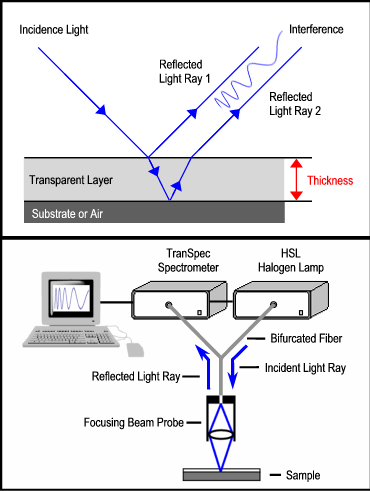A commonly well-known effect, which occurs for example with soap bubbles or on a thin oil film on water, is used here for the determination of the film thickness. You can see many colors which change according to the layer thickness, e.g. when a soap bubble is blown up.
These "colors at thin layers" are based on the interference phenomenon, i.e. on the superposition of light waves, which have been reflected at the front and back side of the layer (at two boundaries with different optical densities).
The undisturbed superposition of the two reflected light rays 1 and 2 leads to periodical amplifications and extinction in the spectrum of a white continuum light source (such as a halogen spectral lamp as a pseudo white-light source). Since the superposition of the two light rays is not purely additive, a so-called interference occurrs.
The interference spectra of thin transparent or semi-transparent layers are measured and analyzed by our TranSpec Prozess Spectrometer or the TranSpec Lite film thickness gauges, as shown in the schematic figure right beside. The sample is illuminated through a bifurcated fiber optics cable, which is connected to the spectrometer and a halogen lamp. The reflected interference spectrum is guided back to the spectrometer, where the spectrum is analyzed and the film thickness is computed.
• Optical method: non-contact, non-destructive. no Beta radiation, no calibration required!
• Fast measurement and film thickness evaluation - within milliseconds!
• Wide thickness measurement range, up to ~ 0.1 to 150 micrometer ( ~ 0.004 to 6 mil )
• High accuracy: typically better ± 0.005 micrometer over the entire thickness range
• Simultaneous determination of double-layers and even triple-layers possible
• Comfortable and easy-to-use software FTM-ProVis Lite and FTM-ProVis Professional
• Powerful programming library FTM-ProLib++ for your own applications
